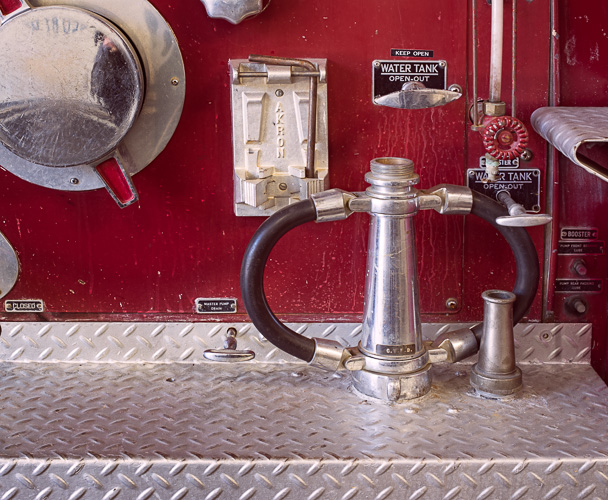After an extensive technical detour that will be familiar to regular readers, yesterday I started back on the Firehouse pictures. I took three cameras, the a7 (for handholding) the a7R, the D800E, and four lenses, the Zony 55 (on the a7), the Zeiss 135mm Apo Sonnar, the Zeiss 55mm Apo Distagon, and the Coastal Optics 60mm macro lens. I ended up not using the a7 at all; the light was too dim. Surprisingly, at least to me, I only made a couple of images with the D800E, both with the 135. Instead, I spent nearly all my time with the a7R and the 55mm Apo Distagon.
I love that lens. First off, it’s got a nice long focusing throw and a silky-smooth action, so it’s a tactile joy to focus. I was shooting entirely with the idea of doing focus-stacking later, and the long throw makes the depth of field markings useful in getting the right focus difference between the pictures in a stack. Second, it’s so contrasty and so fast that there’s hardly ever any doubt when something’s in focus. It goes without saying that it makes really nice images.
Why did I use the a7R in preference to the D800E? I’m not afraid of the a7R’s shutter shock with lenses shorter than 135mm under conditions where I can make sure my exposures are long enough. If the subject’s not moving, I can use a neutral density filter to get the long exposures without having to stop the lens down too far. The Otus only stops down to f/16, so only one stop really suffers from diffraction with that lens.
The live view on the a7R is so much better than that on the D800E that it’s really hard to go back to the Nikon. In addition, I am spending more and more time using the LCD panel for focusing and framing. I don’t think I used the EVF once yesterday. The articulation of the LCD panel makes it easy to use at lowish camera heights that would have my back screaming with the Nikon.
For some reason, looking at the LCD finder, like looking at a ground glass with both eyes, makes it easier for me to compose the picture than using an EVF, or a prism finder, for that matter. I like the grid that you can have the camera superimpose on the image, too. You can always straighten things out in post, but it costs you resolution, and it’s more satisfying to line up the shot right in the camera. However, I think the rule-of-thirds grid is the work of the Devil and an invitation to boring, formulaic pictures.
What’s not to like about the a7R experience for this kind of subject matter? Battery life? Not a problem for me yesterday; I had two spares, and used neither. I had the Monitor/EVF switching set to Auto, and it switched off the LCD panel whenever I got close to the panel to get a really good look at the image. It would be nice if you could switch it to manual, and use one of the custom buttons to toggle it back and forth from the EVF to the LCD panel, but that’s not possible. I’m going to leave it in Auto, and next time I’ll change it to the LCD panel for the shoot, and change it back at the end. Otherwise, I’ll forget that it’s not on Auto, raise the camera to my eye, and be surprised when I can’t see anything. I also had the power saving timeout set to 1 minute, and discovered that that’s not long enough for the kind of work I was doing. I set it to five minutes, which is fine.
I used to think the camera I really wanted was the D4x, but I’m beginning to think that a 54 megapixel a7x with the ability to take leaf-shutter lenses would be awfully nice.



Leave a Reply